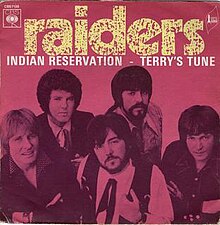Indian Reservation (The Lament of the Cherokee Reservation Indian)
| "Indian Reservation (The Lament of the Cherokee Reservation Indian)" | |
|---|---|
 |
|
| Single by Don Fardon | |
| B-side | "Dreamin' Room" |
| Released | August 1968 |
| Format | 7-inch single |
| Length | 3:23 |
| Label |
|
| Writer(s) | John D. Loudermilk |
| Producer(s) | Miki Dallon |
| "Indian Reservation (The Lament of the Cherokee Reservation Indian)" | ||||
|---|---|---|---|---|
 |
||||
| Single by Raiders | ||||
| from the album Indian Reservation | ||||
| B-side | "Terry's Tune" | |||
| Released | February 1971 | |||
| Format | Vinyl record | |||
| Genre | Rock | |||
| Length | 2:55 | |||
| Label | Columbia | |||
| Writer(s) | John D. Loudermilk | |||
| Producer(s) | Mark Lindsay | |||
| Raiders singles chronology | ||||
|
||||
"Indian Reservation (The Lament of the Cherokee Reservation Indian)" is a song written by John D. Loudermilk. The song was first recorded by Marvin Rainwater in 1959 and released on MGM as "The Pale Faced Indian", but that release stayed unnoticed. The first hit version was a 1968 cover by Don Fardon—a former member of The Sorrows—that reached number 20 on the Billboard Hot 100 and number 3 on the UK Singles Chart.
In 1971, Paul Revere & the Raiders recorded the song on the Columbia Records label, and it topped the Hot 100 on July 24. Raiders lead singer Mark Lindsay is part Cherokee. On 30 June 1971 the RIAA gold certified the record for selling over a million copies. The record was later certified platinum for selling an additional million copies. The song was the group's only Hot 100 number 1 hit and their final Hot 100 top twenty song.
The song refers to the forcible removal and relocation of the Five Civilized Tribes, including the Cherokee people, from the southeastern states of Georgia, North Carolina, Florida, Mississippi and Alabama to the southern Indian Territory in present-day Oklahoma. The removal of these tribes throughout the 1830s is often referred to as the "Trail of Tears". The removal of the Cherokee, Chickasaw, Choctaw, Creek and Seminole came on the heels of President Andrew Jackson's key legislation, the Indian Removal Act of 1830. The Cherokee were the last of the Five Civilized Tribes to be removed after signing the Treaty of New Echota. The removal caused great turmoil within the tribe as members of the Treaty Party were marked for death by Principal Chief John Ross. During the American Civil War the Cherokee were divided between the Ross Faction and the Ridge Faction. The Ross Faction, who had not supported removal and was made up mostly of full blood members of the tribe, remained loyal to the Union. The Ridge Faction, led by Stand Watie, was made up mostly of half blood members of the tribe and due to their southern ways (including owning slaves) sided with the Confederacy. Stand Watie became the last Confederate General to surrender. Following the Civil War, the United States Indian Policy turned to war and forced reservation life for the nations of the Great Plains. The Dawes Act of 1887 was adopted to allow the President to survey Indian lands and divide it up into individual allotments. Under the Dawes Act many Natives were "registered" with the Federal government. However, the law did not apply to the Five Civilized Tribes; instead the Dawes Commission was established in 1893 to convince members of the Five Civilized Tribes to adopt the individual allotments under the Dawes Act. Many Cherokee refused to be registered and as a result another split in the Cherokee Nation occurred. Today the Cherokee maintain their Federal reservation in Oklahoma with pockets living in their ancestral lands of North Carolina and Georgia.
...
Wikipedia
